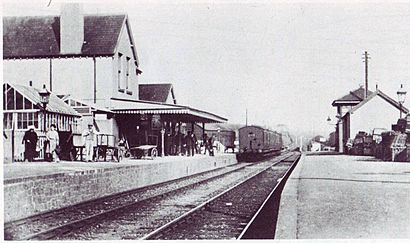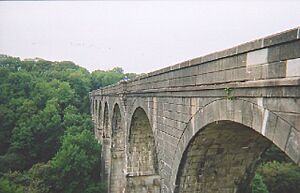Holsworthy railway station facts for kids
Quick facts for kids
Holsworthy
|
|
|---|---|

Holsworthy Station in 1905
|
|
| Location | Holsworthy, Torridge England |
| Platforms | 2 |
| Other information | |
| Status | Disused |
| History | |
| Original company | London and South Western Railway |
| Pre-grouping | London and South Western Railway |
| Post-grouping | Southern Railway British Rail |
| Key dates | |
| 20 January 1879 | Opened |
| 11 August 1898 | Resited when line extended to Bude |
| 3 October 1966 | Closed |
Holsworthy was a railway station in Devon, England. It was located on a railway line that used to run from Okehampton to Bude. The station opened in 1879 to serve the market town of Holsworthy. It closed in 1966 because of something called the Beeching Axe, which was a plan to close many railway lines in Britain.
Contents
Station History
Building the Railway Line
Plans to build a railway line from Okehampton to Bude started way back in 1865. However, this first plan didn't happen. In 1873, a new company called the Devon and Cornwall Railway got permission to build a line. This line would go from Meldon Junction to Holsworthy. At first, Bude wasn't seen as important enough for its own station.
In 1874, the London and South Western Railway (LSWR) bought the Devon and Cornwall Railway. They started building the line the next year.
Holsworthy's First Station
The Holsworthy station opened on 20 January 1879, along with the single railway track. The LSWR company started a horse-bus service from the station to Bude. This helped people travel further.
The station was reached by crossing the Holsworthy Viaduct. A viaduct is like a long bridge that carries a railway or road over a valley or other obstacles. This viaduct was special because it was the first of its kind built completely from concrete. It had nine sections, each 50 feet long.
The New Station and Its Features
By 1898, Bude had grown a lot. Local people wanted the railway line to be extended to the coastal town. So, on 11 August 1898, a new section of the line opened, going all the way to Bude. This meant Holsworthy Station had to be rebuilt. We don't know much about the very first station, as there are no pictures or plans of it.
The new station was quite unique because it was located between two viaducts: Holsworthy Viaduct to the east and Derriton Viaduct to the west. A new signal box with 20 levers was added to control the trains. The old station's turntable (a rotating platform used to turn locomotives around) and engine shed were kept. The turntable was removed in 1911, and the goods shed was taken down in the 1920s.
The goods yard at Holsworthy was very large for a local station. It even had a special track that allowed short trains to go around the station without blocking the main line.
Changes and Closure
For many years, the station was served by the famous Atlantic Coast Express train, which came all the way from London Waterloo. However, this service stopped in January 1963. This happened when the railway line was moved to be managed by the Western Region of British Railways.
This change was a sign of what was to come. Richard Beeching, who was in charge of British railways, suggested closing many lines, including this one. His plan, known as the Beeching Report, was published in March 1963. For its last few years, the trains serving Holsworthy were only Diesel Multiple Units. These were like local trains running between Okehampton and Bude. The station finally closed on 3 October 1966.
Services
| Preceding station | Disused railways | Following station | ||
|---|---|---|---|---|
| Dunsland Cross | British Rail Western Region Bude Branch |
Whitstone & Bridgerule | ||
Holsworthy Today
Town Growth and Transport
Since its station closed in the 1960s, Holsworthy has grown steadily. Its population increased by 15% between 1981 and 1999. The town has also seen more businesses, with new industrial areas being built.
However, Holsworthy still faces challenges with public transport. It's not easy to get to other towns like Bideford, Barnstaple, and Great Torrington by bus, as services are not very frequent. Connections to bigger cities like Exeter and Plymouth are even more limited, sometimes only once a week.
The Ruby Way Cycle Path
To help with the lack of transport and provide a fun way to travel, a cycle path called the "Ruby Way" was created. This path is part of the National Cycle Network. It opened in 2005 and follows the old railway trackbed, linking Holsworthy with Bude and Halwill.
The cycleway brought one of the old railway viaducts, Derriton Viaduct, back into public use. Both the Holsworthy and Derriton viaducts are now owned by Sustrans, an organization that promotes walking and cycling. The local council has made sure that these viaducts and the old railway path are protected from future building work. You can get to Derriton Viaduct using a cool spiraling ramp called the "Cornish Corkscrew."
Devon County Council continues to support this cycleway project. They are buying more sections of the old railway line and planning to connect the Bude to Holsworthy route to other cycle paths, like the Cornish Way.
What's Left of the Station
The original station buildings were taken down after the railway closed. The area where the station used to be was empty for a while. Now, it's been redeveloped and is home to a supermarket and part of a new housing area.
Even with these new developments, the route of the cycle path, which runs along the southern part of the old station site, will be kept safe. The council has also suggested that facilities for cycle path users could be built on the site of the old turntable, which is east of Chapel Street.


